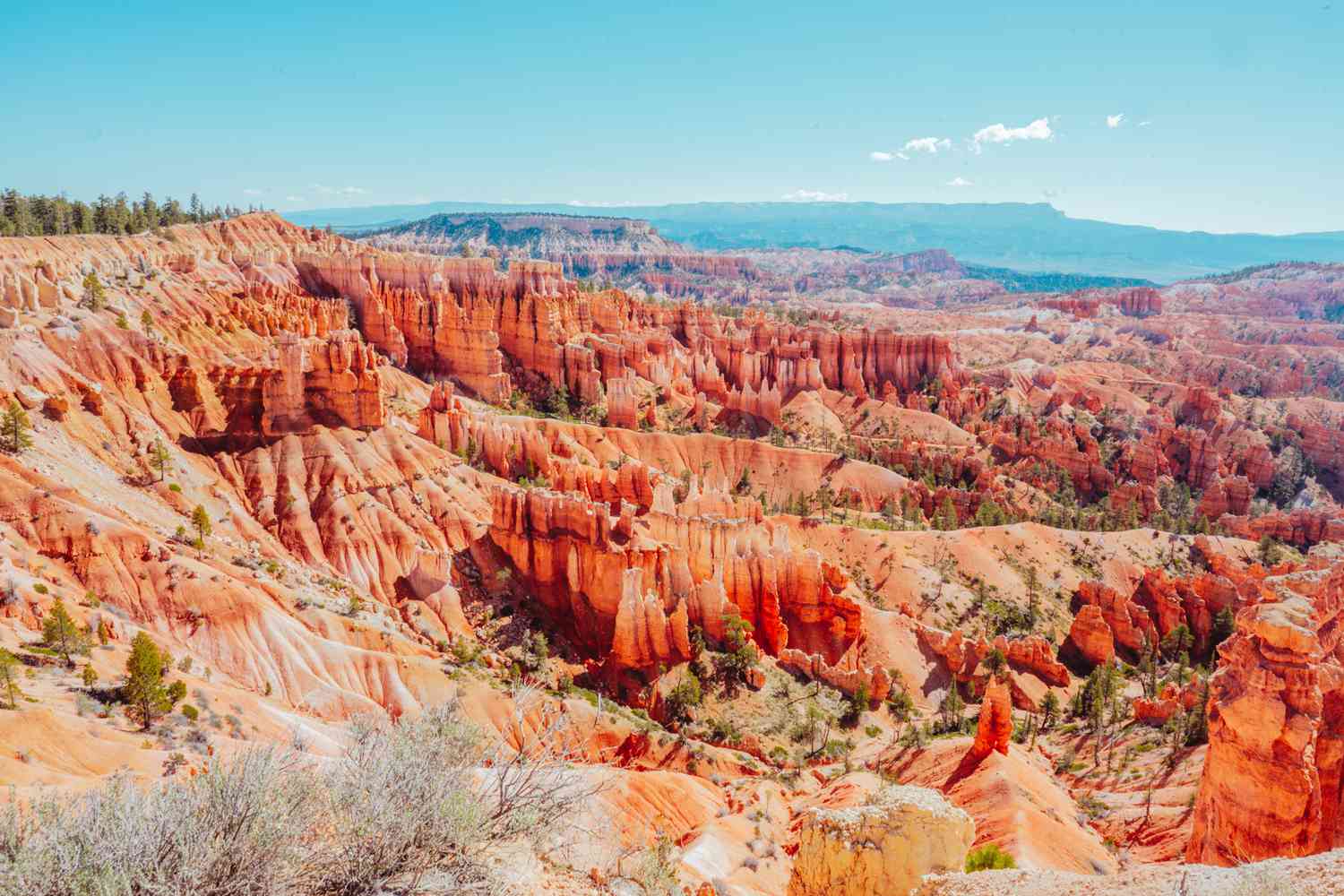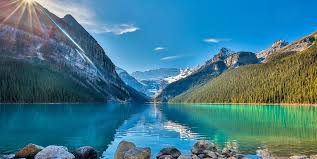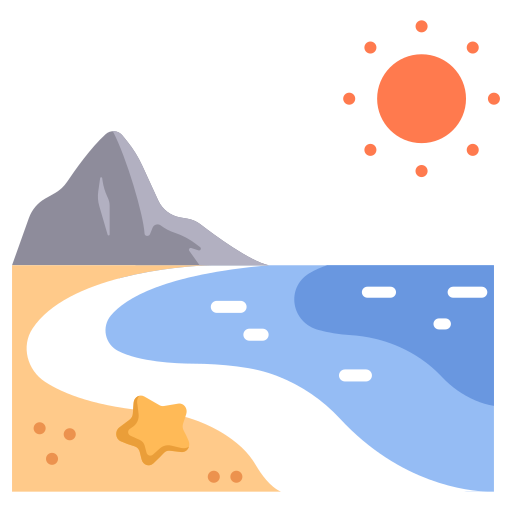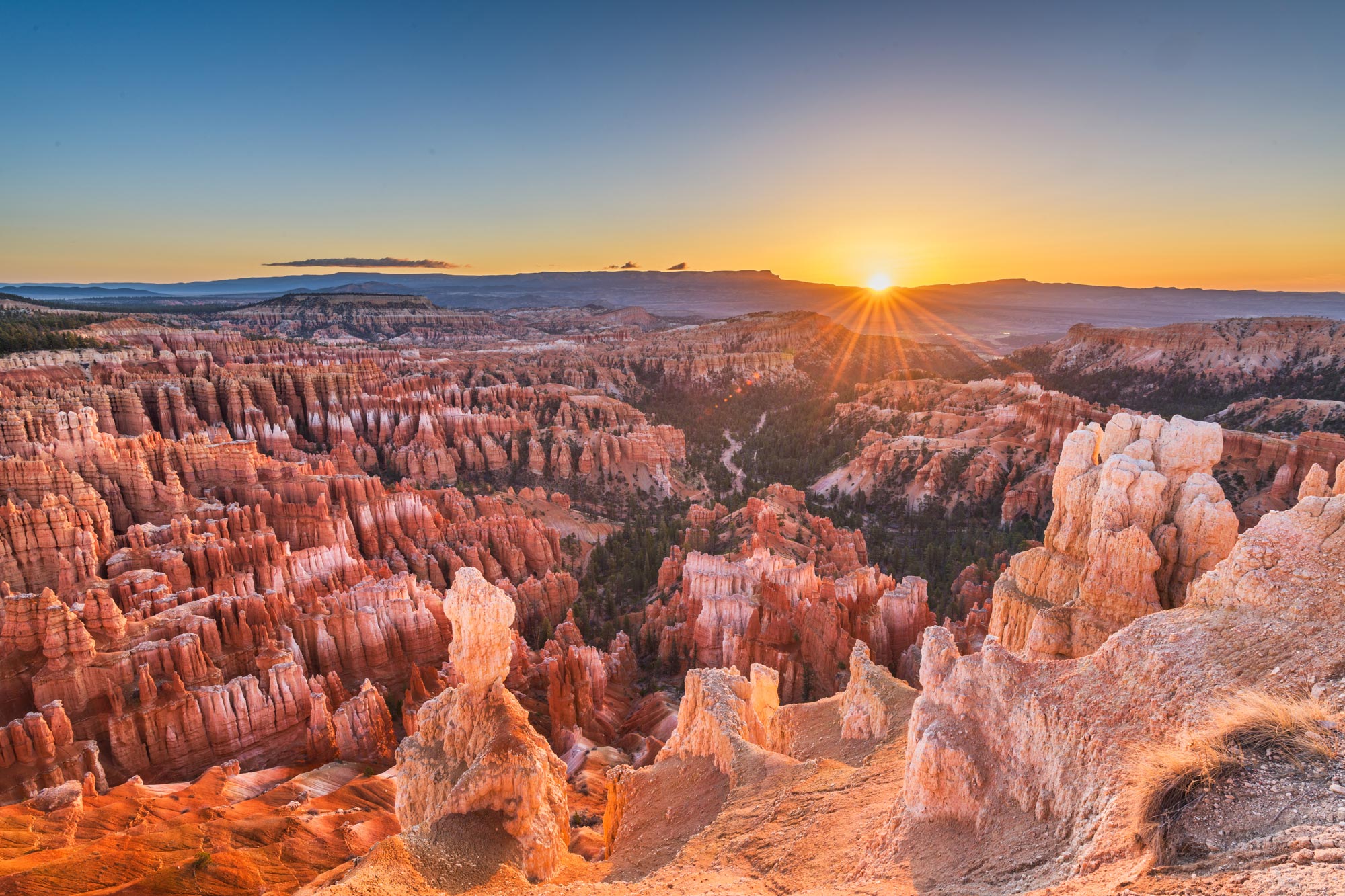
Introduction
A hush falls over the rim at dawn—the air crisp and electric as the first rays ignite the hoodoos in a fiery glow. Inhale deeply, and you can almost taste the cool desert wind mingling with the scent of pine and sandstone. Bryce Canyon whispers of hidden layers: geological time in vibrant reds, quiet forests, and star-dusted nights that beckon the soul.
This place surprises you—from its alien rock sculptures to sudden pockets of alpine tranquility—perfect for impressionable first-timers and seasoned wanderers alike.
Where Is It & Why It Matters
Bryce Canyon National Park sits in southwestern Utah, USA, spanning Garfield and Kane Counties. It’s not a “canyon” in the traditional sense, but a sweeping gallery of natural amphitheaters carved into the Paunsaugunt Plateau.
Prized for its vibrant hoodoos—fragile spires sculpted by frost and erosion—Bryce offers one of the most photogenic landscapes on Earth
Named after Ebenezer Bryce, a Scottish Mormon homesteader who settled near the rim in the late 19th century, the area became a National Monument in 1923 and was elevated to National Park status in 1928. This high-elevation marvel (8,000–9,000 feet) offers far-reaching vistas—on clear days, the horizon stretches across plateaus, cliffs, and distant peaks
Though not UNESCO-listed, it shines as an International Dark Sky Park, recognized for its pristine nighttime skies.
Best Time to Visit
May through September brings warm days and a full slate of ranger programs, perfect for hiking and guides
Spring (Mar–May) unveils wildflowers and bird migration; fall (Sep–Nov) brings cooling temps and golden foliage with thinner crowds
Winter (Nov–Mar) blankets the hoodoos in snow—a photographer’s dream and a gateway to snowshoeing and cross-country skiing—though some roads or facilities may be limited
Off-season perks: quieter paths, lower rates, magical light. Downsides: unpredictable weather and occasional closures to prepare for.
How to Get There & Around
By Air
Major: Las Vegas (LAS) and Salt Lake City (SLC) — both ~270 miles away
Regional: Cedar City (CDC) (~80 mi) and St. George (SGU) (~125 mi)
By Road
Scenic highway routes—especially Highway 12—connect Bryce to attractions like Zion and Capitol Reef
By Train/Bus
No direct service to the park; car rental or shuttle transfers are typical
Local Transport
In-park shuttle (free with entry) runs late May–October along the rim to reduce traffic.
On-foot exploration, ride horseback, or take guided tours from the Visitor Center
Top Attractions You Can’t Miss
- Bryce Amphitheater — heart of the park with sweeping hoodoo views.
- Sunrise Point, Sunset Point, Bryce Point, Inspiration Point — each reveals different moods in light and shadow
- Thor’s Hammer — iconic hoodoo seen best along the Navajo Loop Trail
- Hiking Highlights:
- Easy: Queen’s Garden, Mossy Cave, Rim Trail.
- Moderate: Navajo Loop, Tower Bridge.
- Challenging: Peekaboo Loop, Fairyland Loop
- Night Sky Viewing — one of the top spots for stargazing in the States
- Bryce Canyon Lodge — historic rustic architecture, built in the 1920s and still charming today
Tips: Catch sunrise at Bryce Point for the hoodoos ablaze in soft light; book winter ranger and astronomy events early if they require scheduling
Exploring
Bryce's Beauty
Immerse Yourself
Trending Categories
.png?alt=media&token=77ac3ecc-bdfb-400a-b763-32a5b163b326)
Things to Do
Places to visit and things to do
.png?alt=media&token=77ac3ecc-bdfb-400a-b763-32a5b163b326)
Things to Do
Places to visit and things to do

Beaches
Beaches, costal areas
.png?alt=media&token=77ac3ecc-bdfb-400a-b763-32a5b163b326)
Things to Do
Places to visit and things to do
.png?alt=media&token=77ac3ecc-bdfb-400a-b763-32a5b163b326)
Things to Do
Places to visit and things to do

Beaches
Beaches, costal areas

Beaches
Beaches, costal areas

Casino
Casino, gaming

Casino
Casino, gaming

Parks and Gardens
Park and gardens

Parks and Gardens
Park and gardens

Parks and Gardens
Park and gardens
.png?alt=media&token=77ac3ecc-bdfb-400a-b763-32a5b163b326)
Things to Do
Places to visit and things to do

Beaches
Beaches, costal areas

Casino
Casino, gaming

Casino
Casino, gaming
Category Name
Discover more about this category.
Category Name
Discover more about this category.
Category Name
Discover more about this category.

Parks and Gardens
Park and gardens

category missing
no category

category missing
no category

category missing
no category
.png?alt=media&token=77ac3ecc-bdfb-400a-b763-32a5b163b326)
Things to Do
Places to visit and things to do

category missing
no category

category missing
no category

Museum and Science Center
Step inside a world of discovery, creativity, and learning. Traveling to museums and science centers offers an enriching experience for curious minds of all ages. From exploring art masterpieces in world-renowned museums to engaging with hands-on exhibits in interactive science centers, every visit brings knowledge and wonder to life.
Discover history, culture, and innovation as you wander through exhibits that span centuries and continents. Learn about ancient civilizations, groundbreaking scientific discoveries, and the stories behind iconic inventions. Many museums and science centers also offer immersive experiences, workshops, and live demonstrations that make learning fun and unforgettable.
Perfect for families, students, and solo explorers, these destinations turn education into adventure. Museums and science centers aren’t just stops on a travel itinerary — they’re gateways to understanding the world in deeper, more meaningful ways.

Museum and Science Center
Step inside a world of discovery, creativity, and learning. Traveling to museums and science centers offers an enriching experience for curious minds of all ages. From exploring art masterpieces in world-renowned museums to engaging with hands-on exhibits in interactive science centers, every visit brings knowledge and wonder to life.
Discover history, culture, and innovation as you wander through exhibits that span centuries and continents. Learn about ancient civilizations, groundbreaking scientific discoveries, and the stories behind iconic inventions. Many museums and science centers also offer immersive experiences, workshops, and live demonstrations that make learning fun and unforgettable.
Perfect for families, students, and solo explorers, these destinations turn education into adventure. Museums and science centers aren’t just stops on a travel itinerary — they’re gateways to understanding the world in deeper, more meaningful ways.

Museum and Science Center
Step inside a world of discovery, creativity, and learning. Traveling to museums and science centers offers an enriching experience for curious minds of all ages. From exploring art masterpieces in world-renowned museums to engaging with hands-on exhibits in interactive science centers, every visit brings knowledge and wonder to life.
Discover history, culture, and innovation as you wander through exhibits that span centuries and continents. Learn about ancient civilizations, groundbreaking scientific discoveries, and the stories behind iconic inventions. Many museums and science centers also offer immersive experiences, workshops, and live demonstrations that make learning fun and unforgettable.
Perfect for families, students, and solo explorers, these destinations turn education into adventure. Museums and science centers aren’t just stops on a travel itinerary — they’re gateways to understanding the world in deeper, more meaningful ways.

Museum and Science Center
Step inside a world of discovery, creativity, and learning. Traveling to museums and science centers offers an enriching experience for curious minds of all ages. From exploring art masterpieces in world-renowned museums to engaging with hands-on exhibits in interactive science centers, every visit brings knowledge and wonder to life.
Discover history, culture, and innovation as you wander through exhibits that span centuries and continents. Learn about ancient civilizations, groundbreaking scientific discoveries, and the stories behind iconic inventions. Many museums and science centers also offer immersive experiences, workshops, and live demonstrations that make learning fun and unforgettable.
Perfect for families, students, and solo explorers, these destinations turn education into adventure. Museums and science centers aren’t just stops on a travel itinerary — they’re gateways to understanding the world in deeper, more meaningful ways.

Nature and Wildlife
Nature / Wildlife

Nature and Wildlife
Nature / Wildlife

Nature and Wildlife
Nature / Wildlife

Theater
Step into a world of drama, music, and unforgettable performances. Theater travel is all about experiencing the magic of live shows, from Broadway spectacles in New York and West End productions in London to traditional plays in Japan and opera performances in Italy. Every theater destination offers a unique story, atmosphere, and cultural flavor.
Beyond entertainment, theater travel lets you connect with local culture, artistry, and history. Attend musicals, dramas, ballets, and experimental performances that showcase creativity and talent from around the world. Many destinations also offer backstage tours, workshops, and interactive experiences for those who want to dive deeper into the art of theater.
Perfect for solo travelers, couples, and culture enthusiasts, theater journeys turn evenings into unforgettable memories. Discover the power of storytelling, witness world-class performances, and let every show inspire, entertain, and move you.

Theater
Step into a world of drama, music, and unforgettable performances. Theater travel is all about experiencing the magic of live shows, from Broadway spectacles in New York and West End productions in London to traditional plays in Japan and opera performances in Italy. Every theater destination offers a unique story, atmosphere, and cultural flavor.
Beyond entertainment, theater travel lets you connect with local culture, artistry, and history. Attend musicals, dramas, ballets, and experimental performances that showcase creativity and talent from around the world. Many destinations also offer backstage tours, workshops, and interactive experiences for those who want to dive deeper into the art of theater.
Perfect for solo travelers, couples, and culture enthusiasts, theater journeys turn evenings into unforgettable memories. Discover the power of storytelling, witness world-class performances, and let every show inspire, entertain, and move you.

Theater
Step into a world of drama, music, and unforgettable performances. Theater travel is all about experiencing the magic of live shows, from Broadway spectacles in New York and West End productions in London to traditional plays in Japan and opera performances in Italy. Every theater destination offers a unique story, atmosphere, and cultural flavor.
Beyond entertainment, theater travel lets you connect with local culture, artistry, and history. Attend musicals, dramas, ballets, and experimental performances that showcase creativity and talent from around the world. Many destinations also offer backstage tours, workshops, and interactive experiences for those who want to dive deeper into the art of theater.
Perfect for solo travelers, couples, and culture enthusiasts, theater journeys turn evenings into unforgettable memories. Discover the power of storytelling, witness world-class performances, and let every show inspire, entertain, and move you.

Lakes
Discover tranquility, adventure, and breathtaking scenery at some of the world’s most stunning lakes. Lake travel offers a unique blend of natural beauty and recreational opportunities — from serene reflections in the Swiss Alps and the turquoise waters of Canada’s Moraine Lake to vibrant houseboats on India’s Dal Lake.
Whether you’re kayaking across crystal-clear waters, enjoying a lakeside picnic, or simply soaking in the peaceful surroundings, lakes provide the perfect escape from city life. Many destinations also offer hiking trails, local villages, and wildlife spotting, giving travelers a full experience beyond the water.
Ideal for couples, families, and solo explorers, lake getaways combine relaxation, adventure, and nature in one unforgettable journey. Experience the calm, capture stunning views, and let the serene beauty of lakes inspire your next adventure.

Lakes
Discover tranquility, adventure, and breathtaking scenery at some of the world’s most stunning lakes. Lake travel offers a unique blend of natural beauty and recreational opportunities — from serene reflections in the Swiss Alps and the turquoise waters of Canada’s Moraine Lake to vibrant houseboats on India’s Dal Lake.
Whether you’re kayaking across crystal-clear waters, enjoying a lakeside picnic, or simply soaking in the peaceful surroundings, lakes provide the perfect escape from city life. Many destinations also offer hiking trails, local villages, and wildlife spotting, giving travelers a full experience beyond the water.
Ideal for couples, families, and solo explorers, lake getaways combine relaxation, adventure, and nature in one unforgettable journey. Experience the calm, capture stunning views, and let the serene beauty of lakes inspire your next adventure.

Lakes
Discover tranquility, adventure, and breathtaking scenery at some of the world’s most stunning lakes. Lake travel offers a unique blend of natural beauty and recreational opportunities — from serene reflections in the Swiss Alps and the turquoise waters of Canada’s Moraine Lake to vibrant houseboats on India’s Dal Lake.
Whether you’re kayaking across crystal-clear waters, enjoying a lakeside picnic, or simply soaking in the peaceful surroundings, lakes provide the perfect escape from city life. Many destinations also offer hiking trails, local villages, and wildlife spotting, giving travelers a full experience beyond the water.
Ideal for couples, families, and solo explorers, lake getaways combine relaxation, adventure, and nature in one unforgettable journey. Experience the calm, capture stunning views, and let the serene beauty of lakes inspire your next adventure.

Mall or Market
Explore the heartbeat of a city through its malls and markets. Mall and market travel is more than shopping — it’s a cultural experience, blending local flavors, craftsmanship, and modern retail in one exciting journey. From bustling street markets in Marrakech and Bangkok to luxury malls in Dubai and New York, every destination offers unique finds and memorable experiences.
Wander through stalls filled with handmade crafts, spices, and souvenirs, or indulge in high-end brands, gourmet dining, and entertainment under one roof. Markets give you a taste of local life and traditions, while malls offer convenience, style, and world-class amenities — making every shopping trip an adventure.
Perfect for families, solo travelers, and shopaholics, these destinations combine exploration, culture, and retail therapy. Discover treasures, savor local delicacies, and experience the vibrant energy that makes every market and mall a must-visit on your journey.

Mall or Market
Explore the heartbeat of a city through its malls and markets. Mall and market travel is more than shopping — it’s a cultural experience, blending local flavors, craftsmanship, and modern retail in one exciting journey. From bustling street markets in Marrakech and Bangkok to luxury malls in Dubai and New York, every destination offers unique finds and memorable experiences.
Wander through stalls filled with handmade crafts, spices, and souvenirs, or indulge in high-end brands, gourmet dining, and entertainment under one roof. Markets give you a taste of local life and traditions, while malls offer convenience, style, and world-class amenities — making every shopping trip an adventure.
Perfect for families, solo travelers, and shopaholics, these destinations combine exploration, culture, and retail therapy. Discover treasures, savor local delicacies, and experience the vibrant energy that makes every market and mall a must-visit on your journey.

Mall or Market
Explore the heartbeat of a city through its malls and markets. Mall and market travel is more than shopping — it’s a cultural experience, blending local flavors, craftsmanship, and modern retail in one exciting journey. From bustling street markets in Marrakech and Bangkok to luxury malls in Dubai and New York, every destination offers unique finds and memorable experiences.
Wander through stalls filled with handmade crafts, spices, and souvenirs, or indulge in high-end brands, gourmet dining, and entertainment under one roof. Markets give you a taste of local life and traditions, while malls offer convenience, style, and world-class amenities — making every shopping trip an adventure.
Perfect for families, solo travelers, and shopaholics, these destinations combine exploration, culture, and retail therapy. Discover treasures, savor local delicacies, and experience the vibrant energy that makes every market and mall a must-visit on your journey.

Art and Entertainment
Art / Entertainment

Art and Entertainment
Art / Entertainment

Art and Entertainment
Art / Entertainment

Mall or Market
Explore the heartbeat of a city through its malls and markets. Mall and market travel is more than shopping — it’s a cultural experience, blending local flavors, craftsmanship, and modern retail in one exciting journey. From bustling street markets in Marrakech and Bangkok to luxury malls in Dubai and New York, every destination offers unique finds and memorable experiences.
Wander through stalls filled with handmade crafts, spices, and souvenirs, or indulge in high-end brands, gourmet dining, and entertainment under one roof. Markets give you a taste of local life and traditions, while malls offer convenience, style, and world-class amenities — making every shopping trip an adventure.
Perfect for families, solo travelers, and shopaholics, these destinations combine exploration, culture, and retail therapy. Discover treasures, savor local delicacies, and experience the vibrant energy that makes every market and mall a must-visit on your journey.

Science Center or Museum
Science Center or Museum

Science Center or Museum
Science Center or Museum

Nature and Wildlife
Nature / Wildlife

Science Center or Museum
Science Center or Museum
Important Links
- Destinations
- About Us
- Blogs
Become A Member
Join the HopDays
community of travelers
© 2024 HopDays. All rights reserved. No part of this site may be reproduced without our written permission.
Important Links
- Destinations
- About Us
- Blogs
Become A Member
Join the HopDays community of travelers
© 2024 HopDays. All rights reserved. No part of this site may be reproduced without our written permission.
